The Impact of Streaming Services on Music: From Vinyl to Digital Domination
October 20, 2024

The music industry has undergone a dramatic transformation over the last few decades. From the era of vinyl records to the rise of cassette tapes, CDs, and MP3s, how we consume music has continuously evolved. However, perhaps the most significant shift in recent years has been the rise of streaming services. Platforms like Spotify, Apple Music, and YouTube have fundamentally changed how we access and experience music, reshaping the industry from the ground up.
In this article, we’ll explore how streaming services have impacted the music industry, the shift from physical formats to digital platforms, and what the future of music might look like in a world dominated by streaming.
A Brief History of Music Consumption: From Vinyl to Streaming
Before diving into the impact of streaming services, it’s important to understand the historical context of how music consumption has evolved over time.
1. The Era of Vinyl Records
The mid-20th century marked the golden age of vinyl records, with LPs and 45s becoming the primary formats for listening to music. During this era, albums were considered cherished physical objects, and the experience of playing music on a turntable was as much about the tactile ritual as it was about the sound. Vinyl records also emphasized the importance of the album as an art form, with cover art, liner notes, and song arrangements playing an essential role in the listener’s experience.
2. Cassettes and CDs: The Rise of Portability
In the late 20th century, cassette tapes and later compact discs (CDs) introduced a new level of portability to music. Cassettes allowed for easier sharing and recording, while CDs offered superior sound quality and durability. However, these formats were still tied to physical media, with listeners needing to own the physical product to enjoy the music.
3. The Digital Revolution: MP3s and Downloads
The late 1990s and early 2000s saw the advent of the digital revolution, with the rise of MP3 files and platforms like Napster, iTunes, and other digital download services. This period marked a shift from physical media to digital music files, allowing users to store vast libraries of music on their computers or portable devices. It also paved the way for the fragmentation of albums, as listeners began to prioritize individual tracks over entire albums.
4. The Streaming Revolution
Today, we find ourselves in the age of music streaming. Streaming services like Spotify, Apple Music, Amazon Music, and YouTube have overtaken physical sales and downloads as the dominant way people listen to music. With access to millions of songs at the tap of a finger, streaming has reshaped how we discover, consume, and even think about music.
The Impact of Streaming on the Music Industry
The rise of streaming services has had profound effects on the music industry, changing the dynamics for both artists and consumers.
1. The Decline of Physical Sales and Downloads
Streaming has led to a significant decline in physical music sales and digital downloads. According to the Recording Industry Association of America (RIAA), streaming now accounts for more than 80% of all recorded music revenue in the U.S. Sales of CDs, vinyl, and digital downloads have plummeted as consumers increasingly prefer the convenience of streaming.
- Vinyl’s Niche Resurgence: Despite the dominance of streaming, vinyl records have experienced a surprising resurgence among collectors and audiophiles. While vinyl sales have grown in recent years, they still represent a small fraction of overall music consumption compared to streaming.
2. Shifting Revenue Models: From Album Sales to Streaming Royalties
One of the most significant changes brought about by streaming is how artists and record labels generate revenue. In the past, artists relied heavily on album sales and digital downloads for income. However, streaming services use a subscription model (or, in some cases, ad-supported models), where revenue is distributed to artists based on the number of streams their songs receive.
- Streaming Royalties: For every play, artists earn a fraction of a penny—streaming payouts typically range from $0.003 to $0.005 per stream, depending on the platform. This has led to criticism from many musicians, especially independent and smaller artists, who argue that the revenue from streaming is not enough to make a sustainable living.
- Shift in Power Dynamics: As a result, the music industry has seen a shift in power dynamics, with top-tier artists and popular streaming playlists commanding the majority of streams and revenue, while lesser-known artists struggle to break through.
3. The Playlist Era: Changing How We Discover Music
The introduction of curated playlists on platforms like Spotify and Apple Music has fundamentally changed how listeners discover music. In the past, radio DJs, music critics, or album purchases were primary sources of music discovery. Today, algorithmically generated playlists like Spotify’s Discover Weekly or Apple Music’s New Music Mix introduce users to new tracks based on their listening habits.
- Rise of Singles Over Albums: With playlists becoming a dominant form of music discovery, the importance of albums as cohesive works of art has diminished. Instead, artists are increasingly focusing on singles, aiming for short-term chart success and playlist placements to maximize streams.
- Algorithms and Discovery: Streaming platforms use sophisticated algorithms to analyze user behavior and recommend songs tailored to individual tastes. This means listeners are often introduced to music they might not have found through traditional means, leading to a more personalized and diverse listening experience.
The Pros and Cons of Streaming for Artists and Consumers
While streaming services offer many benefits, they also come with challenges—especially for artists navigating the new digital landscape.
Pros of Streaming:
- Accessibility: Streaming services offer instant access to millions of songs from all over the world. Whether you’re at home, commuting, or traveling, you can listen to virtually any song on demand.
- Affordability: For consumers, streaming services provide an affordable way to access vast music libraries. A monthly subscription costs far less than buying individual albums or tracks.
- Global Reach: For artists, streaming provides an opportunity to reach a global audience. Independent musicians can upload their tracks to streaming platforms and potentially gain a worldwide fanbase without needing a record label.
- Data and Analytics: Artists and record labels have access to detailed data and analytics about listener habits, including geographic locations, play counts, and more. This helps musicians make informed decisions about touring, marketing, and releasing new music.
Cons of Streaming:
- Low Artist Payouts: One of the most significant downsides of streaming is the low payout per stream. For many artists—especially independent musicians—streaming revenue alone is not enough to make a living, pushing them to rely on alternative income streams like touring, merchandise, and licensing deals.
- Loss of Album Experience: With the rise of playlists and single-track consumption, many argue that the album experience—once considered a cohesive artistic statement—has been diminished. In the age of streaming, listeners are more likely to consume individual tracks rather than entire albums.
- Oversaturation and Competition: With millions of tracks available on streaming platforms, the market has become oversaturated. For smaller or independent artists, standing out in a crowded field can be incredibly challenging, making it difficult to gain visibility or secure a place on popular playlists.
Streaming’s Impact on Music Culture
Streaming has not only changed the business side of music but also impacted the culture surrounding how we experience and value music.
1. The Demise of Music Ownership
In the age of vinyl, cassettes, and CDs, music ownership was a significant part of the listening experience. Fans would build physical collections, often prizing rare or limited-edition releases. Streaming has shifted the focus from ownership to access, with listeners now renting music through subscription services rather than owning it outright. This shift has changed how we value music as a cultural artifact.
2. Shorter Attention Spans and the Rise of Microgenres
Streaming has also contributed to a trend of shorter attention spans in music consumption. With millions of tracks available, listeners can easily skip songs after a few seconds. This has led to artists and producers crafting music with immediate hooks to capture attention early.
At the same time, the global reach of streaming has given rise to microgenres—niche music genres that gain small but dedicated followings online. Streaming services have made it easier for these microgenres to flourish, connecting listeners and artists from different parts of the world.
The Future of Music in the Age of Streaming
As streaming continues to dominate the music landscape, several trends and developments are worth watching.
- Exclusive Content and Streaming Wars: Just as we’ve seen with video streaming platforms like Netflix and Disney+, the music industry is starting to see the rise of exclusive content deals. Major artists may sign exclusive streaming agreements with platforms like Apple Music or Tidal, creating a competitive landscape in the streaming market.
- Blockchain and NFTs: Some artists are experimenting with blockchain technology and NFTs (non-fungible tokens) as new ways to distribute music and generate revenue. NFTs offer a way for artists to sell unique digital assets, providing a potential alternative to traditional streaming royalties.
- Direct-to-Fan Models: Platforms like Bandcamp have gained popularity by offering a more artist-friendly approach, allowing musicians to sell their music and merchandise directly to fans while retaining a larger share of the revenue. This trend could continue as artists seek new ways to monetize their music outside of traditional streaming platforms.
Conclusion: From Vinyl to Streaming – A Revolution in Music Consumption
The rise of streaming services has undoubtedly transformed the music industry in profound ways. While it offers unparalleled access to music and opportunities for global exposure, it also presents challenges, particularly for artists struggling with low payouts and the oversaturation of the market. As the industry continues to evolve, the balance between convenience for consumers and fair compensation for artists remains a critical issue.
Ultimately, streaming has become the dominant force in modern music consumption, shaping how we discover, enjoy, and value music. From vinyl to digital domination, the evolution of music formats tells the story of technological innovation, shifting listener habits, and the ever-changing nature of the music industry.






